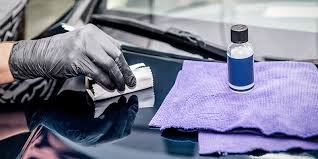Step-by-Step: What to Expect from a Ceramic Coating Course

If you’re passionate about cars and detailing, you’ve probably heard about ceramic coatings and their incredible benefits. These coatings not only enhance the appearance of your vehicle but also provide long-lasting protection against various environmental factors. But how do you learn to apply ceramic coatings effectively? This is where a ceramic coating course comes into play! In this article, we’ll take you through a step-by-step guide on what to expect from a ceramic coating course. For more details, check out the Ceramic Coating Course.
Understanding Ceramic Coatings
1. What Are Ceramic Coatings?
Ceramic coatings are liquid polymers that chemically bond with the paint of your vehicle, creating a protective layer. This layer shields the car from UV rays, dirt, and other harmful contaminants. Unlike traditional waxes and sealants, ceramic coatings can last for several years with proper maintenance, making them a popular choice among car enthusiasts.
2. Why Take a Ceramic Coating Course?
Taking a ceramic coating course is essential for anyone looking to master this advanced detailing technique. Not only will you learn how to apply coatings correctly, but you’ll also gain valuable knowledge about surface preparation, product selection, and industry best practices. This course will help you stand out in the competitive world of automotive detailing.
What to Expect: The Course Overview
3. Course Structure
Most ceramic coating courses are structured to provide a mix of theoretical knowledge and practical experience. You’ll start with classroom sessions that cover the science behind ceramic coatings, followed by hands-on training where you’ll practice the application techniques.
4. Duration of the Course
Ceramic coating courses can vary in length, typically ranging from one to three days. The duration depends on the depth of the material covered and the amount of hands-on training included. Longer courses often offer more comprehensive instruction, including business-related aspects of detailing.
Step-by-Step Breakdown of the Course
5. Introduction to Ceramic Coatings
The first part of the course usually includes an introduction to ceramic coatings, where you’ll learn about:
- Different types of coatings: Understanding the variety of ceramic coatings available on the market and their specific applications.
- Product chemistry: Learning how ceramic coatings work and why they provide superior protection compared to traditional waxes.
6. Surface Preparation
Proper surface preparation is critical for a successful ceramic coating application. In this section, you’ll learn about:
- Washing techniques: How to effectively wash a vehicle to remove dirt and contaminants without damaging the paint.
- Decontamination: Using products like clay bars to remove embedded contaminants that could interfere with bonding.
- Paint correction: Understanding the steps necessary to correct imperfections like scratches and swirl marks before applying the coating.
7. Application Techniques
Once the vehicle is prepped, it’s time to dive into the application techniques. You’ll cover:
- Choosing the right tools: Understanding the equipment needed for a successful application, including applicator pads and polishing machines.
- Application methods: Learning how to apply the coating evenly and effectively to ensure maximum coverage and durability.
- Curing process: Knowing how long the coating needs to cure and the conditions required for optimal results.
8. Hands-On Practice
The hands-on portion of the course is where the real learning happens. You’ll get the chance to:
- Work on real vehicles: Under the supervision of experienced instructors, you’ll apply what you’ve learned on actual cars, gaining invaluable experience.
- Receive feedback: Instructors will provide constructive criticism to help you improve your technique and build confidence.
Post-Application Care and Maintenance
9. Maintaining Ceramic Coatings
After applying a ceramic coating, proper maintenance is crucial for its longevity. The course will cover:
- Washing and drying techniques: Learning the best practices for keeping a coated vehicle clean without degrading the coating.
- Routine inspections: Knowing what to look for to ensure the coating is performing well and addressing any issues promptly.
10. Troubleshooting Common Issues
You’ll also learn about common problems that may arise during or after application and how to address them effectively. This knowledge will prepare you to handle various scenarios with confidence.
Conclusion
Enrolling in a ceramic coating course is an investment in your skills as a detailer. Not only will you gain hands-on experience and expert knowledge, but you’ll also be equipped to offer top-notch services to your clients. Whether you’re looking to start a new career in detailing or enhance your existing skills, a ceramic coating course is essential for achieving excellence in automotive care.
If you’re ready to dive into the world of ceramic coatings and take your detailing skills to the next level, don’t hesitate to check out the Ceramic Coating Course. With the right training, you’ll unlock the secrets of automotive perfection and become a sought-after detailer in your area!
